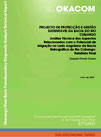Transboundary Diagnostic Analysis
 Innovative methodology was used to design
and carry out the TDA process. A previous effort in 1997 had not
increased the Commission’s understanding of ecosystem linkages and
processes. This time EPSMO focused on issues expressed as possible
future pressures, hoping to achieve alternate pictures of the future of
the river, based on development scenarios.
Innovative methodology was used to design
and carry out the TDA process. A previous effort in 1997 had not
increased the Commission’s understanding of ecosystem linkages and
processes. This time EPSMO focused on issues expressed as possible
future pressures, hoping to achieve alternate pictures of the future of
the river, based on development scenarios.
Based on sound scientific analysis and expert opinion this TDA aimed to anticipate the environmental, social and economic impacts and the requisite policy and institutional challenges of flow regime change due to developments in the basin due to abstractions, impoundments, land use change or climate change.
The Okavango TDA took the present state of the basin, and projected development and water use trends into the future and anticipated the threats and potential consequences that might arise from a development pathway based on increasing water resources development, providing a bridge between water resources development and the potential for accruing global benefits without generating further loss of ecosystem function.
Scientific Teamwork
In 2008, a full multi-disciplinary team was appointed in each country, with specialists in hydrology, hydraulics, channel form, water quality, vegetation, aquatic invertebrates, fish, birds, river-dependent terrestrial wildlife, resource economics and socio-cultural issues, coordinated and managed by a group of specialists from the southern African region.
The teams began with analysis of the of the baseline – the present state of the ORB – continuing through an in-depth analysis – the Integrated Flow Assessment -- of representative sites along the river, and a basin-wide macro analysis. For the purpose of the study, the basin was segmented into homogenous units – called Integrated Units of Analysis or IUAs – so that data and knowledge for any one site could be extrapolated over a wider area. Known hydrological data for the basin were used to calibrate the hydrological models. National Coordinating Units in the three river basin countries then decided which water resource development scenarios they wished to consider. A representative site in each of the eight most important IUAs was chosen as the focal point for data collection and interpretation.
Biophysical indicators (river attributes that could change with flow change) and socio-economic indicators (social attributes that could change with river change) were jointly chosen by the country teams. The country teams collected and synthesised all known data on the indicators, working in discipline groups, and carried out new research as the project allowed. The specialists wrote reports of their findings and described the flow-river ecosystem, and rover-social wellbeing relationships. These relationships were captured in a custom-built Decision Support System (DSS). The hydrological team simulated the changes in flow at the eight representative sites under each scenario. The DSS was then queried to predict how these flow changes would impact the indicators chosen to represent the river ecosystem and the peoples’ social structures.
The in-depth assessment on the eight representative sites provided the scientific basis for this analysis by linking water resources development with flow, ecology and socio-economics at the specific sites. The basin-wide studies allowed these observations to be extrapolated to the rest of the basin and also highlighted basin-wide trends and issues possibly emerging from the changes in the river. The ‘links’ connecting developments in one country to impacts in another are the four characteristics of flow: timing, quantity, quality and sediment. The Okavango causal chain analysis was predictive of problems that may arise as a result of future development in the basin. Climate change, as an overarching factor, was judged important enough to be given its own separate study.







 GEF IW:LEARN
GEF IW:LEARN